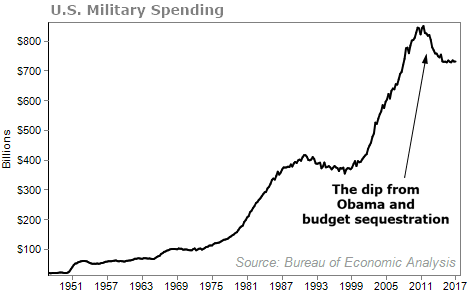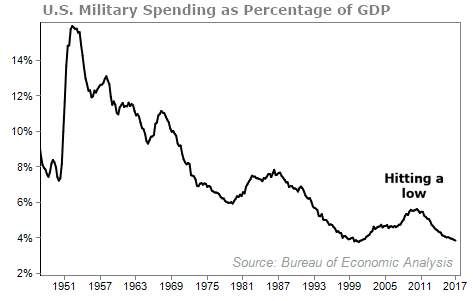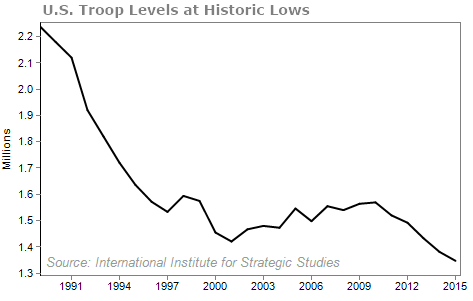| Home | About Us | Resources | Archive | Free Reports | Market Window |
|
The Weekend Edition is pulled from the daily Stansberry Digest. The Digest comes free with a subscription to any of our premium products.
The Closest Thing to a 'No Lose' Proposition in Today's MarketBy
Saturday, July 15, 2017
The sharp decline in U.S. military spending.
If you're like most folks, this comes as a surprise. After all, for years we've heard about the billions of dollars spent on various defense projects, and how the U.S. spends more on its military than any other country.
Doc says the reality isn't so simple. As he explained in a new special report for his Retirement Millionaire subscribers...
As Doc explained, this decline is a result of both Obama-era decisions to slow military spending, along with "sequestration" cuts forced by the Republican-led Congress following arguments about the debt ceiling. But he says even those figures don't tell the whole story...
Today, those threats remain. But the "superpowers" have now returned. Countries like Russia, China, and North Korea increasingly represent a threat. And Doc noted that our "insurgent focused" military simply isn't prepared to deal with them...
U.S. military spending will rise significantly in the coming years.
You see, while most folks aren't aware of these problems, those at the top levels of the military are... And they're determined to fix them. More from Doc...
We certainly hope the U.S. avoids a major new conflict. And longtime readers know we aren't fans of unnecessary government spending.
But as Doc noted, even if the government chooses to take a smaller role on the "world stage," better technology is needed to keep pace with China and other growing powers.
Either way, more spending is virtually guaranteed. And a handful of companies will be the biggest beneficiaries...
As you'd expect from Doc, they're all high-quality companies that treat their shareholders well. These stocks should continue to do well even if spending doesn't rise as expected. But if Doc is right, they could absolutely soar over the next few years. And should a new conflict break out, the sky is truly the limit.
In short, buying these stocks is as close to a "no lose" proposition as you'll likely find in the markets today.
Of course, if you're familiar with Doc's Retirement Millionaire advisory, you know it's about much more than building your wealth. It's also about protecting the health and well-being of those you love.
That's why folks who agree to try Retirement Millionaire today won't just get his special report on the best ways to profit from this trend...
You'll also get Doc's no-nonsense book on preparedness, called The Doctor's Protocol Field Manual. Unlike any other book we've seen on the subject, Doc's is based on facts, science, and real medicine, rather than hype.
Doc has also partnered with renowned geopolitical expert Richard Maybury to show you exactly how to prepare for the growing risks of war and global conflict. You'll get Richard's new research report – "How to Survive and Flourish During America's Next Episode of Great Wealth Destruction" – and one full year of his must-read U.S. & World Early Warning Report.
Best of all, for a limited time, you can get it all for less than the usual cost of a Retirement Millionaire subscription. And as always, it comes with Doc's 30-day, 100% money-back guarantee.
If you're not already reading Retirement Millionaire, there has never been a better time to give it a try. Click here to sign up now.
Regards,
Justin Brill
Editor's note: Doc recently put together a report that details his top five defense investments today. As a DailyWealth reader, you can get instant access to these recommendations... a copy of Doc's book, The Doctor's Protocol Field Manual... all his research for one year... and more for just $99 (a savings of nearly $300). Get all the details right here.
|
Recent Articles
|




